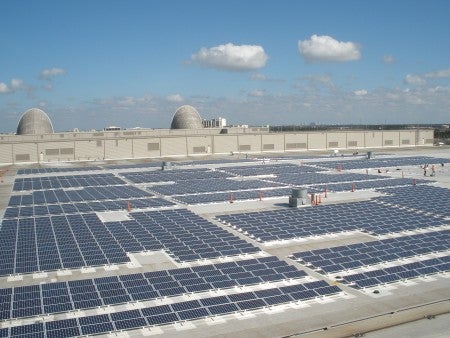 If Brevard County attracts a high-tech consortium to perform photovoltaic research and manufacturing, it could be because of established strengths in the solar energy field.
If Brevard County attracts a high-tech consortium to perform photovoltaic research and manufacturing, it could be because of established strengths in the solar energy field.
A research hub, the Florida Solar Energy Center in Cocoa — which has a staff of 150 — was created in 1975 and is one of the main reasons Brevard County was chosen to vie for a photovoltaic manufacturing consortium that could bring up to 300 research jobs to the county, Lynda Weatherman, president and CEO of the Economic Development Commission of Florida’s Space Coast, said.
The center has earned more than 40 patents and has been recognized as a leader in alternative energy research, winning the institution a string of awards.
James M. Fenton, center director, said he believes that photovoltaic research could be the key to energy independence for the U.S. and the key to economic development for Central Florida, which will suffer huge job losses when the shuttle stops flying, idling up to 8,000 highly skilled space industry workers.
Sematech Inc., based in Austin, Texas, is partnering with the University of Central Florida, Enterprise Florida and others to compete for win a $50 million grant from the U.S. Department of Energy to make solar energy competitive fossil fuels. A Palm Bay building donated to UCF by Intersil Corp., would become the corporate headquarters and research and development center.
The Sunshine State receives twice as much usable sunlight as Germany, which by implementing research programs has come to lead the world in solar technology and photovoltaic electricity- generation. Research and manufacturing could create an industry whose profits and benefits would remain in Central Florida.
As research advances the technology of photovoltaic panels, it is becoming less expensive to generate electricity from solar — which makes it a viable, pollution-free alternative to burning imported fossil fuels.
“Two years from now it’ll be cheaper,” Fenton said. “In lots of other states it already is cheaper because they’re paying a lot more for electricity.”Brevard also has a fledgling photovoltaic electricity-generating program, which has given the county experience in photovoltaic power. A one-megawatt and a 10-megawatt photovoltaic electricity-generating facility was built near Kennedy Space Center,
In April, FPL commissioned its Space Coast Next Generation Solar Energy Center on NASA property. It produces an estimated 10 megawatts of emissions-free power from 35,000 solar panels, which is enough to power 1,100 homes.
The 60-acre, $70 million solar center will save about 122,000 barrels of oil and 2.8 billion cubic feet of natural gas over its lifetime, FPL estimated.
Florida’s regulatory environment, however, does not favor solar energy development, and this could delay a photovoltaic industry in Brevard County. A state solar rebate program has gone unfunded and the state has no goal or mandate to generate a percentage of its power from solar.
“If we don’t get on the bandwagon, we are missing a job bonanza,” said Sam Cochrane, president of Russell & Sun Solar in Malabar, which installs solar and photovoltaic systems at residence and businesses. “What other industry is growing like the renewable industry?”
Cochrane’s company installs systems that can pay for themselves over 10 years. And he expects the price of such systems to fall by half in a few years.
Officials leading the recruitment effort believe Brevard can succeed in developing this vital industry.
“The goal of this project is to reach grid parity within five years, so that photovoltaic is no longer alternative energy, which is just a buzzword to say it costs more,” M.J. Soileau, UCF vice president for research and commercialization said. “It’s a Wild West out there now in the photovoltaic manufacturing world. There’s no clear leaders out there, except corporate China. And if you like Chinese drywall, you’ll love Chinese photovoltaics.”
Source: Florida Today, Brevard ripe for solar high-tech center, by Patrick Peterson at 242-3673 or ppeterson@floridatoday.com